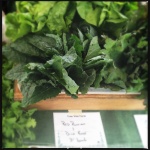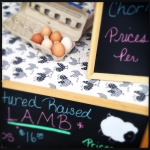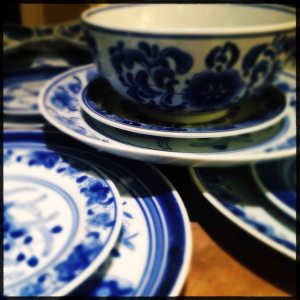There is no food problem so complex as scientific marketing, complex because so many elements enter into a day’s dietary.
Marian Cole Fisher, Twenty Lessons in Domestic Science; 1916.
A number of years ago I read an article in the New York Times about a cult favorite home-keeping book titled Mrs. So-and-So’s Something. Obviously, that was not the real title. I clipped the article and started searching eBay for the book until I got bored/distracted/called to other tasks and lost interest. Then I lost the article.
A few year later I was thinking of giving vintage home-keeping books to my friends for Christmas, and I remembered the book, only not the title. I searched eBay for weeks, never finding that original holy grail (hard to search for Mrs. So-and-so’s something); but I unearthed some other wonderful tomes in the process.
My favorite discovery, which did not leave the house wrapped in red and green but rather sits on my kitchen shelf, is Marian Cole Fisher’s Twenty Lessons in Domestic Science (1916). The lessons, in order, are these:
- Function of Foods
- Leavening Agents
- Cakes and Their Process
- Yeast Bread
- Milk and Eggs
- Cheese
- Fish
- Meats
- Vegetables
- Potatoes
- Rice
- Vegetables Containing Nitrogen and Starch
- Vegetables, Green and Succulent Salad Plants
- Edible Weeks
- Herbs
- Condiments
- Fruits
- Miscellaneous Recipes Simplified
- Beverages
- Equipment of the Kitchen
Tucked in between pages somewhere in the middle of the book I also found a postcard labeled “Home Management” with a grid for tracking over a five month period, the following metrics:
- Number better health practices adopted
- Number working surface heights measured
- Number working surfaces wrong height
- Number working surface heights corrected
- Number persons to whom work has been given
- Remarks
It’s unclear to whom the postcard was to be mailed once completed, but since the postage was printed on the address side ($.01), it was obviously intended as some official report.
The juicy details of the book (juicy only if you’re the cooking sort) include the value of unpolished rice, the importance of light and ventilation, balanced rations, and scientific explanations of leavening and yeast breads. In the section about meat the author notes that meat loses some of its protein during cooking if not properly seared.
But my favorite part of the book is the “Introductory,” which focuses on Marketing (Family Budget).
Marketing, by which she means the procuring of provisions, is, she notes, the most complex food problem.
The writer has not found the PARCELS POST altogether a satisfactory method of procuring produce – your local merchants who are, perchance, your neighbors, will feel a more intimate need for providing the quality commensurate with price than someone fifty or one hundred and fifty miles away, to whom you cannot return undesirable merchandise.
The more things change, the more they stay the same.
Happy week.
*****
Food | Week of February 17, 2014
The surprise in our house last week was that my children were cuckoo for the Thai beef with coconut rice. I had made it before, but not for them and wasn’t sure how it would go. I didn’t use as many peppers as the recipe suggested, so they didn’t find it too hot. They also liked the week’s experiment, Moroccan chicken with lemon couscous, although I agree with some of the reviewers that the couscous had a bit too much lemon.
This week will include Braised Lentils from Mark Bittman’s How to Cook Everything Vegetarian, which I have to return to the library but may put on my Amazon wish list. It’s been surprisingly good, compared to my experiences with Bittman’s NYT-published recipes, and it has some good general tips. The book also got a thumbs up from Michelle at Gourmandistan, a terrific and beautiful food blog that features, among other gems, a delicious recipe for Salty Caramel Ice Cream.
We’ll also have a couple of standard fare items for poor long-suffering Bernard, who can make it five or six weeks with the recipe program before he pleads for meatloaf or chicken and dumplings. And the experiment for the week will be a French onion soup recipe from Food 52. Believe it or not, I’ve never made French onion soup at home. It will be either Saturday or Sunday’s dinner because of the long cooking time. Back-up plan if my people don’t like it: grilled cheese.
Parmesan Chicken | French Green Beans | Berry Salad
 Ina Garten’s Parmesan chicken recipe is simple and reliable; I’m also fond of my friend Marjorie’s version which calls for marinating the chicken in Italian dressing for a bit before cooking and using that same dressing instead of an egg wash before breading. Serve with steamed French beans and a green salad with strawberries.
Ina Garten’s Parmesan chicken recipe is simple and reliable; I’m also fond of my friend Marjorie’s version which calls for marinating the chicken in Italian dressing for a bit before cooking and using that same dressing instead of an egg wash before breading. Serve with steamed French beans and a green salad with strawberries.
Braised Lentils Spanish Style | Baguette
This recipe for lentils, from How to Cook Everything Vegetarian, isn’t available through Bittman’s blog or on the NYT, but here’s a link to its appearance on the Culinary-Quest blog. If you have the book, there are several alternative seasoning suggestions along with the primary recipe (all on p. 598). We may try the Moroccan alternative instead of Spanish; I reserve the right to decide that real-time.
Louisiana Gumbo | Rice
I found this recipe for gumbo a while ago on Adam Holland’s terrific blog The Unorthodox Epicure. It’s easy to make, I promise, and also easy to adjust to your tastes.
 Chicken Fried Steak | Mashed Potatoes | English Peas
Chicken Fried Steak | Mashed Potatoes | English Peas
Just for Bernard, we’ll have a comfort dinner one night. If you need a recipe for chicken-fried steak, here’s a link to Ree Drummond’s (Pioneer Woman) from the Food Network site. As a short aside, my favorite comfort dinner as a child was cube steak, mashed potatoes and green peas. I suspect I’ll cook my steak without batter….
French Onion Soup | Baguette | Arugula Salad
Here’s the experiment, my first foray into the mysterious world of French Onion Soup. I’m going to try this recipe from Food 52. For the salad I’ll probably combine arugula, roasted beets, walnuts and a bit of cheese with a balsamic vinaigrette. And, again, my back-up plan for my people will be grilled cheese.


5 responses to “20 Lessons in Domestic Science.”
Jenny,
I’m on the side of the poor long-suffering Bernard. Marian Cole Fisher’s list could be shortened to steak, baked potato, beer. The three main food groups. Butter, sour cream & chives required for the baked potato.
Patrick
LikeLike
🙂
LikeLike
I absolutely adore old books about housekeeping and cooking and will buy almost anything from 1900 to WWII-era. (Though with respect to the former, one need go only a decade or so back to Cheryl Mendelson’s Home Comforts to feel utterly inferior.) Thanks for the shout-out and do try many of the Asian recipes in HTCEV (e.g., the spicy pickles, the kimchi, the twice-fried green beans). They are quite good.
LikeLike
Thanks, Michelle. By the way, I made some of your sesame dressing tonight for dinner, and it was delicious!
LikeLike
[…] wrote last week that Bernard had reached the “I need simple comfort food” point, and that I was going […]
LikeLike